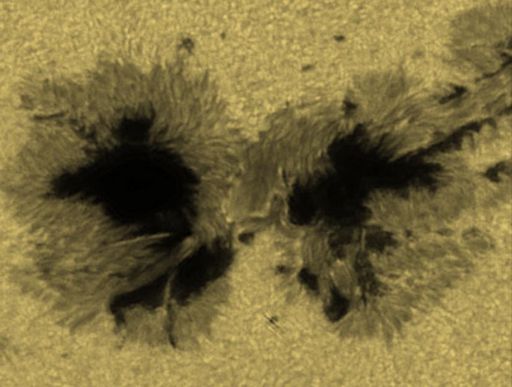CME DELAYED: A CME expected to sideswipe Earth's magnetic field on Feb 2nd did not arrive on time. A new analysis by NOAA forecasters suggests it will reach Earth on Feb. 4th instead. The late arrival could spark minor geomagnetic storms and auroras on Tuesday. Aurora alerts: text, voice
BIG SUNSPOT, HIGH SOLAR ACTIVITY: Solar activity reached high levels yesterday with seven M-class solar flares and three CMEs. Almost all of the explosions were produced by monster sunspot AR1967, shown here in a photo from Chris Schur of Payson, Arizona:
Click to view the entire sunspot. AR1967 is wider than the planet Jupiter and its primary dark cores are big enough to swallow Earth many times over. The scale of the thing makes it an easy target for backyard solar telescopes. "I used an Explore Scientific AR152 to take the picture," says Schur. "This is one of the most photogenic sunspots I have ever seen."
AR1967 has a 'delta-class' magnetic field that harbors energy for strong eruptions. The growing complexity of the region has prompted NOAA forecasters to boost the odds of X-flares to 50% during the next 24 hours. Because AR1967 is near the center of the solar disk, any eruptions will be squarely Earth directed. Solar flare alerts: text, voice

Solar wind
speed: 355.3 km/sec
density: 3.7 protons/cm3
explanation | more data
Updated: Today at 1636 UT
X-ray Solar Flares
6-hr max: C7 1254 UT Feb03
24-hr: C9 0830 UT Feb03
explanation | more data
Updated: Today at: 1600 UT
![]()
Daily Sun: 03 Feb 14
Earth-facing sunspot AR1967 has a 'beta-gamma-delta' magnetic field that harbors energy for X-class solar flares. Credit: SDO/HMI
![]()
Sunspot number: 163
What is the sunspot number?
Updated 03 Feb 2014
Spotless Days
Current Stretch: 0 days
2014 total: 0 days (0%)
2013 total: 0 days (0%)
2012 total: 0 days (0%)
2011 total: 2 days (<1%)
2010 total: 51 days (14%)
2009 total: 260 days (71%)
Update 03 Feb 2014
The Radio Sun
10.7 cm flux: 166 sfu
explanation | more data
Updated 03 Feb 2014
![]()
Current Auroral Oval:
Switch to: Europe, USA, New Zealand, Antarctica
Credit: NOAA/POES
![]()
Planetary K-index
Now: Kp= 1 quiet
24-hr max: Kp= 2 quiet
explanation | more data
Interplanetary Mag. Field
Btotal: 5.3 nT
Bz: 2.2 nT north
explanation | more data
Updated: Today at 1637 UT
![]()
Coronal Holes: 03 Feb 14
There are no large coronal holes on the Earthside of the sun. Credit: SDO/AIA.





